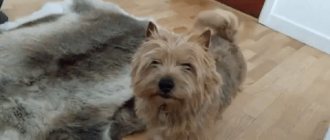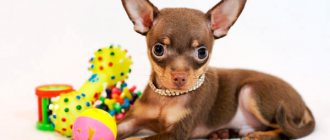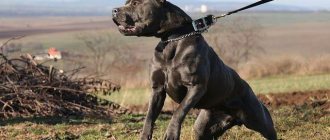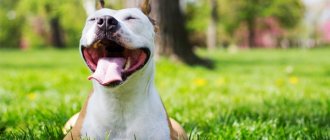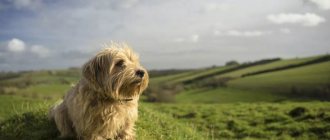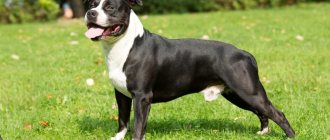Description of the Norwich Terrier breed
Popularity 29th among 263 dog breeds
Lifespan:
12-15 years
Breed group:
Decorative
Height:
25-26 cm
Country of origin:
Great Britain
Average price:
40-50 thousand rubles
Weight:
5.5 kg
Latest articles Cat health
Rabies vaccination for cats: choice of vaccine, necessity, schedule 01/22/2022 4 0 0
Selection and adaptation
TOP 20 best cat breeds for families with children 01/22/2022 25 0 0
Advantages and disadvantages
- Pros:
- good health;
- flexible and peaceful disposition;
- unpretentiousness in daily care;
- developed intelligence, understanding;
- good adaptation to new living conditions.
- Minuses:
- rare and expensive breed;
- feeding with high-quality premium food;
- the need for education and training at an early age;
- excessive activity, the need for long walks with increased physical activity;
- love of dirt, garbage, digging in the earth, swimming in a puddle.
Key facts
Norwich Terriers are small and strong dogs with a brave heart. Wonderful hunters and cute, playful and sociable pets can be kept in a small apartment or country cottage.
Despite their friendly and peaceful nature, it is better for Norwich breeders to be adopted by experienced dog breeders, since only proper training can turn fidgets into obedient and intelligent dogs.
Norwich Terriers are suitable for large active families and single people with some free time. But pets will not be able to live outside home and family, sit on a chain or in an enclosure - without sufficient attention, they fall into stress, which is accompanied by uncontrollable behavior.
Description of the Norwich Terrier breed combines:
- high intelligence;
- playfulness and energy;
- friendliness;
- restraint;
- caution;
- devotion to the owner.
Little children love dogs very much, the only condition is mutual respect. It is better not to take Norwich Terriers into a house where there are other pets (rodents, cats, birds), as their innate hunting instinct makes them attack anything that is smaller in size.
Characteristics of the Norwich Terrier breed include the following facts:
- Country of origin: Great Britain, late 19th century.
- Character traits are cheerful, friendly, curious, courageous animals with developed intelligence, who try to please their breeder in everything. They are easy to train and take part in everything that happens around them.
- With proper nutrition, care, and maintenance, the life expectancy of a Norwich Terrier is about 14 years.
- Care - the coat should be combed 3-4 times a week, bathing should be done when dirty. Clean your eyes daily, ears – 3 times a week, trim your nails 2 times a month.
Animals that easily adapt to new living conditions can be kept in a country house or apartment - but only with long active walks outside. The ornamental breed is attractive to breeders due to its small size, good health, ease of upbringing, training, and unpretentiousness in nutrition and daily care.
Character and behavior
By nature, Norfolks are cheerful, cheerful and good-natured dogs. Representatives of the breed are very flexible, sociable, quickly become attached to their owners and always try to be in the center of events.
Patient pets get along well with children and are ready to play with them tirelessly. They will not offend even the most annoying child. True, it is better to protect your pet from small children: the child does not always calculate his strength and can injure the dog.
These dogs of this breed are quite good-natured towards strangers. If the owner is distracted, the Norfolk can calmly leave after the stranger.
Despite their modest size, Norfolk Terriers are distinguished by their amazing courage. In case of danger, they always come to the defense of their owners.
Norfolk Terriers usually get along well with other dogs living in the house. But sometimes the owner can be jealous of other animals. These dogs do not like cats, but only in cases where they have not known them since childhood.
They may even begin to hunt for the decorative rodent. For this reason, it is better not to have rats, hamsters or guinea pigs in a house where a Norfolk Terrier already lives.
History of the origin of the Norwich Terrier
It is believed that England is the homeland of dogs. Initially, the cute creatures lived in Norfolk. Their external similarity with Yorkshire terriers is not accidental - the ancestors of the latter were English terriers, which were bred from Irish terriers and Yorkshires. It is worth mentioning a related breed of dogs - Norfolk Terriers, which differ from Norwich dogs in the shape of their ears.
For many years the animals were used in Great Britain as skilled and courageous hunters of small and large rodents. Local residents called them “rattlers” (rat - translated as “rat”). Despite their peaceful nature, their compact size dogs were excellent at exterminating “uninvited guests” who raided grain barns. This is what made them so popular among the British.
The fame of dogs as magnificent and charming hunters spreads throughout the country, and later throughout the world. In the 1980s, Norwich Terriers became the official mascot of Cambridge. Adorable kids have caused a sensation among students on an English university town - they were queuing up to become the owner of a fashionable pet. So the hunting breed acquired another unofficial name - “Cambridge Terrier”.
In the 30s of the 20th century, breeder F. Jones continued to work on the appearance of the dogs, crossing Irish Glen of Imaal Terriers with Cairn Terriers. The result of the work was the appearance of puppies with floppy and erect ears, which until 1932 belonged to the same breed.
But the breeders were not satisfied with this state of affairs, and they turned to the English Kennel Club with a request to divide similar-looking dogs into different breeds to get rid of competition. In 1965, their request was granted, and the fold-eared animals were called “Norfolk Terriers”, and the dogs with erect ears were called “Norwich Terriers”.
The animals owe their appearance in America to the athlete R. Strawbridge, who returned from Great Britain with a male named Viluum, and then he participated in the breeding of the American line of Norwich dogs. The popular ratcatchers were added to the registry of the US Kennel Club in 1935. The division of the breed into “Norfolk” and “Norwich” on the mainland occurred in 1978.
Kennel clubs for breeding elite breeds began to appear in America at the end of the 20th century. And these days, dogs are valued for their funny, pretty appearance, playful, cheerful and flexible character, and boundless devotion to their owner. The hunting qualities of pets have faded into the background.
Appearance of the Norwich Terrier
General impression
In the photo, Norwich Terriers are stocky dogs with a careless appearance. In reality, animals have a streamlined, strong body and are distinguished by elegance and grace.
Head
Rounded, with a convex skull, deep stops, pronounced brow eyebrows. The dimensions of the Norwich Terrier's muzzle and head are in the ratio of 2 to 3. The transition between the frontal bone and the nose is quite sharp. Small ears are erect, with pointed tips. When the animal is calm, they stick out back; when excited about something, the ears point slightly forward.
Norwich eyes are oval with a slit, recessed into the skull, which protects them from external blows and damage. The eyelids tightly cover the eyeball and are dark in color.
The iris is black or dark brown. Dogs have a cheerful, curious look. The teeth are quite large, white, strong jaws form a correct bite.
Neck
Its length corresponds to the dimensions of the dog. She is muscular and strong. The scruff and dewlap are weakly visible.
Torso
Rectangular in shape, the bones are strong and flexible. The chest is quite narrow and elongated, formed by paired arched ribs, which allows the dog to easily crawl into holes. The back is short, smoothly blending into the lower back and sloping croup. The groin and stomach do not sag.
Front and hind limbs
The front legs are less muscular. The shoulders are protruded towards the shoulder blades, smoothly turning into the forearms. Elbows touch the sternum. Strong pasterns are located vertically. Rounded limbs with pads filled, like those of a cat, always “look” forward. The claws are strong.
The hind legs are well developed and wide. The mid-length thighs are strong, the hock joints are well defined. They are located low, which, together with short metatarsals, provides the animal with a good push. The pads are voluminous, the claws are painted in dark colors.
Tail
According to the breed standard, the Norwich tail can be of natural length or shortened - it is set high and completes the line of the back. The tail is thicker at the base, but it gradually tapers towards the end. When the animal moves, it is positioned perpendicular to the ground.
Movement
Due to the flexible joints, the animal has a low stroke and pushes off powerfully from the surface. The hind legs are rearranged behind the front legs. The line of the back is parallel to the ground, regardless of the developed speed.
Wool
The coat of the Norwich is as hard as wire and sticks out to the sides. The neck is decorated with a “collar” of elongated guard hair. The round head is covered with short, smooth hair. In the area of the mouth and eyes there is “vegetation” in the form of a “mustache,” “beard,” and “eyebrows.” The undercoat is quite dense.
Norwich Terrier colors
Dogs come in three standard colors: reddish - from cream, pale yellow to red; grayish; black with reddish splashes. Dogs may have dark spots of varying shapes and sizes on their limbs and ears.
Norwich Terrier size
The height of the Norwich Terrier at the withers ranges from 20 to 25 cm, males are larger than females. The Norwich Terrier weighs up to 6 kilograms.
Price
The cost of such a pet is quite high. We advise you to go for him to one of 2 capital nurseries with a good reputation, “Sugar” or “Ketcher”. By collaborating with them, you can rest assured that you are paying for a healthy and high-quality representative of the breed.
You will also receive information about its maintenance, feeding, vaccinations, etc. Moreover, you will never lose contact with the breeders from the nursery. At any time they will advise you on all issues regarding keeping or raising a dog.
The minimum price for a Norwich Terrier in Russia for 2019 is 35 thousand rubles. Show or breed class puppies cost from 40 to 55 thousand rubles. It is also worth considering the costs of grooming, veterinary hospitals, food and, possibly, transportation of the animal.
Norwich Terrier personality
Miniature dogs have earned the love of breeders due to their cute appearance and good-natured, reserved and fearless character. These animals are always ready to stand up for their owners and themselves.
Norwich are sociable pets that require increased attention, care and love, which is why they need the presence of members of the household. They quickly get used to the rules of living, get along easily with other pets, but do not tolerate loneliness well. The dog will definitely burst into a protracted howl - the displeasure of the neighbors will be ensured.
Norwich feels the “weather” in the house; in a tense moment, he is able to defuse the atmosphere with an unusual acrobatic stunt or a funny prank. The respect of the Norwich will not be easy to win for people with a soft-hearted character - the hunting breed is suitable for breeders who can easily become a leader in an improvised “pack”.
As for the protective qualities of Norwich Terriers, many dog breeders agree that they are absent. Despite the developed hunting instinct - vigilance, little rat catchers have a good-natured and cheerful disposition, so they are quicker to wag their tails than to rush into a swift attack. Do not rely on the protection of property - dogs are ready to ignore the appearance of a stranger on the premises in response to a tasty treat or kind words.
Training by an experienced dog handler will improve the situation, but you should not rely on the pet’s excellent protective qualities. Therefore, if you are looking for a dog to guard your house or apartment, it is better to get a different breed.
The activity, energy, and playful attitude of Norwich dogs is the main reason why small dogs feel comfortable in families with small children. And the older the baby, the better - the four-legged friend will not tolerate disrespect: he will not bite, but he will also refuse to play further.
The friendly nature of Norwich Terriers allows you to bring other pets into your home. Dogs get along well with small four-legged animals, but cats are tolerated only if there is no reason for jealousy.
There is no need to place birds and small rodents next to Norwich cats - natural instinct will definitely work, and even the owner’s loud, strict commands will not help in this case. Punishment or complete isolation will not improve the situation - the pet will definitely launch a real hunt for a hamster, parrot or rat, which will end in success.
Important! The Norwich Terrier often exaggerates its own importance, which causes clashes with larger dogs. If training by a professional does not give the desired results, an extreme measure will be required - castration (relevant for males who are not planned to be used in breeding\breed).
Terriers are characterized by excessive mobility. They require regular and long walks outside with increased physical activity, which will keep furniture and household items intact. Keep your four-legged friend busy chasing a ball, overcoming an obstacle course, or searching for hidden things and objects. During the game, the Norwich Terrier will throw out all the excess energy and leave you alone until the next walk.
Which owner is it suitable for?
The Cambridge Terrier is best adopted by more experienced dog breeders, because despite its kind and friendly character, this breed was bred for hunting. Therefore, the owner of this dog must be able to train it well.
Important! Norwich is also suitable for busy people, since, as mentioned above, it tolerates periods of loneliness well.
The physical level of the person who adopts such a terrier must meet the dog’s requirements for activity. You will need to take the Norwich for long, frequent walks, not let him off the leash, and train his hunting skills.
Education and training
Due to the fact that the animal is capable of becoming the leader in the “pack”, from the first day of its appearance in the home, it should immediately be shown who is the boss. Establish an area where the dog is allowed to roam freely. If you want the dog not to enter the nursery or bedroom, make it clear that a closed door is a significant reason to stay at the threshold and patiently wait for the owner to come.
The animal should be trained to behave correctly in the first days of living with the family - the slightest disobedience, chasing birds and cats, biting arms and legs, jumping on people around them should be stopped immediately. Ideally, if the dog ignores passers-by and street animals, this will avoid many problems. But it is not worth preventing Norwiches from meeting and communicating with their relatives, since early socialization is important for the hunting breed.
Norwich Terriers are considered four-legged pets with well-developed intelligence, so training them is simple and easy. To achieve excellent results, the breeder needs to be patient and consistent in his actions. Be prepared for the fact that the dog may become stubborn and refuse to follow commands.
Do not skimp on kind words and encouragement in the form of various goodies, and then the upbringing and training of the Norwich Terrier will go as it should. Abuse, rudeness and disrespect will only alienate the pet, and it will no longer see the owner as a leader.
Particular attention should be paid to activity - Norwich dogs are incredibly active and energetic, which allows them to take part in competitions in agility, freestyle, and other types of “dog” sports. In this case, the intervention of an experienced specialist will not be superfluous. Increased physical activity and rewards for successfully completed exercises will turn your cute four-legged friend into a real champion, of whom the whole family will be proud.
Application
A barn rat catcher or one whose task is to drive foxes out of their holes. These are its original functions, similar to the Wire and Smooth Fox Terriers .
Nowadays, the Norwich Terrier is basically a loyal friend and intelligent companion of a person.
Of course, he is not the one who can sit in his arms while you walk around the city with friends. He needs movement.
Representatives of this breed are very kind to children. The main thing is that the child does not torture the puppy
Norwich Terrier Health and Diseases
Norwich dogs naturally have excellent health and immunity, but, like other hunting dogs, they are susceptible to some specific diseases.
Possible diseases
In rare cases, Norwich people are diagnosed with:
- epilepsy;
- congenital inferiority of the hip joints;
- anatomical deformation of the tracheal rings;
- narrowing of the lumen of the nostrils of the nose, leading to breathing problems.
Usually these are congenital pathologies, and in good nurseries, puppies are tested for suspected defects. In extremely rare cases, the congenital disease does not appear until midway through the dog's life.
Proper maintenance, care and proper nutrition will help you avoid other health problems. Timely vaccination of the animal is also important: the first vaccinations are given in the nursery, the subsequent ones - by the owner himself. Particular attention should be paid to the prevention of helminths, ticks, and fleas.
Important! Diarrhea, prolonged vomiting, shortness of breath, cough, repeated refusal to eat and prolonged general lethargy are reasons to consult a veterinarian. If a problem is identified, he will prescribe the necessary medications, but you should not self-medicate - this will only aggravate the situation.
Reproductive health
The main problem in crossing Norwich Terriers is finding a purebred partner. In Russia, the hunting breed is not widespread, so for mating it is better to contact a professional nursery, where they will select a purebred dog (bitch) with a pedigree.
When knitting, you should adhere to the following rules:
- Mating is best done in the morning, in the male’s territory.
- Be sure to do parasite prevention before doing this.
- Do not breed relatives, as well as individuals under 18 months of age.
If matings and offspring are undesirable, it is better to resort to castration surgery. It is performed on both males and females. After the intervention, the animals’ sexual desire disappears, they become calmer and more “at home.”
Features of feeding and diet
Norwich cats have an excellent appetite, which is why they are often obese. They can be fed natural products and dry food. It is better not to use combined nutrition, as this will cause disruption in the functioning of the digestive system.
When choosing food for miniature dogs, it is better to choose the “holistic” or “super-premium” class with a large amount of minerals and healthy vitamins. Hard granules will protect the animal’s teeth from the formation of soft plaque. Wet food is best given to puppies, pregnant and lactating bitches, and elderly animals.
As for natural food, it should contain at least 65% meat. Boiled or raw lean beef without tendons and cartilage, chicken and rabbit meat are suitable. It can be combined with boiled boneless sea fish.
The Norwich diet should contain sufficient amounts of by-products: boiled beef liver and raw heart. Cereal porridges with finely chopped fruits, vegetables and herbs will also not be superfluous. Food should be enriched with vegetable oil (serving – one tablespoon), this will improve the condition of the animal’s coat, claws, skin and stimulate digestion.
It is better to avoid the following products:
- fatty meat (pork, lamb);
- river fish;
- milk;
- legumes;
- berries with seeds;
- tubular bones;
- flour products;
- sweets;
- spices and herbs.
There should always be clean water in the dog’s bowl (bottled or running water that has been standing for 24 hours). Boiled water can lead to the formation of kidney stones in the animal.
What to feed?
Meat products are the best food for dogs. But you can’t feed her exclusively meat. You need to include fish, dairy products, and cereals in your diet.
Vegetables and fruits are not included in the daily diet of the wild ancestors of dogs, but to enrich the diet with vitamins, they should sometimes be included in the menu.
In order not to waste time and effort on preparing food from natural products, you can offer your pet dry or wet food, which already contains everything necessary.
With proper care and feeding with natural products, the Norwich Terrier will live for 15 years.
Care and maintenance
Miniature dogs can live in a private house and a city apartment, but an aviary and a chain on the street are definitely not suitable for them. Care and maintenance of the Norwich Terrier are quite simple. The coat should be brushed with a soft brush several times a week, and when shedding, every day.
If the pet lives indoors, its fur does not get tangled, and remains clean for a long time - a rare bath (once a month) is enough. It is recommended to periodically trim the Norwich, it will look well-groomed and tidy. To do this, you need to contact a specialist - independent trimming can cause pain to the animal, leaving bald patches or tangled pieces of fur on the body.
The ears and eyes of Norwich Terriers are not prone to disease, but they need to be examined several times a week and, if discharge is detected, be sure to clean them with a cotton swab soaked in veterinary lotion. If your pet is walked on a leash and is not allowed to run freely on the street, it cannot grind its claws off on the asphalt on its own - it will require trimming with sharp scissors or tongs.
Watch for unpleasant odor from the mouth, which can be caused by bad food, dental or gastrointestinal problems. In the first case, you will need to completely change your diet; in the rest, you will need to seek help from a veterinary clinic.
Caring for puppies
Before you get a Norfolk Terrier puppy, you need to read and follow these recommendations:
- Before the puppy arrives in the house, he will be equipped with a sleeping place, away from drafts, dampness and heat sources. Ideally, it is placed as close to the owner as possible.
- If dewclaws are present, it is recommended that they be removed during puppyhood.
- Small Norfolk Terriers often bite their owners when hand-fed. This can be avoided in the future by weaning your dog off biting as early as possible.
- It is forbidden to walk with the baby before vaccination, as well as for 2 weeks after it.
- Norfolk Terrier puppies are very inquisitive, so all potentially dangerous objects (toxic substances, electrical wires, small objects) are safely hidden.
An important point in caring for a Norfolk Terrier puppy is nutrition. The diet of a small pet should be rich in essential vitamins and minerals.
You need to feed your baby strictly according to the schedule:
- at 2–4 months – 5–6 times a day;
- from 4 months to six months – 4 times a day;
- at 6–10 months – 3 times a day;
- after 10 months - twice a day.
Tips for choosing a puppy
Choosing a Norwich baby is not an easy task. In this matter, it is important to pay attention to the following parameters:
- The appearance must correspond to the standard: wedge-shaped muzzle, clearly visible stop, correct teeth bite, erect ears. The baby should be moderately well-fed, the eyes should be clear, the coat should be thick and shiny, the palate should be pink, and the area under the tail should be dry and clean.
- The baby is taken away from the mother dog no earlier than 3 months of age, when all the basic rules of behavior and socialization have been instilled.
- Behavioral characteristics - a Norwich Terrier puppy should be sociable, inquisitive, active, and immediately make contact.
- You should get acquainted with the pedigree, awards and achievements of the puppy’s parents. Even better is to ask the breeder for a health certificate.
When choosing a Norwich, pay no less attention to his gender. Bitches are calmer and good-natured, males are wayward, disobedient, and always strive for leadership.
How to choose a puppy
You can buy a healthy baby with good heredity only in an official nursery. Ask the breeder about his successful experience in breeding Norwich Terriers, the conditions in which the dogs are kept, their titles and awards (if relevant). It is quite difficult to determine by eye whether a puppy meets the breed standard, so it is worth using the services of an expert. It will protect you from purchasing a discarded Norwich Terrier that will not be able to participate in exhibitions.
Before meeting the puppies, it is worth meeting their parents. A few minutes of communication will be enough for a superficial overview of the shortcomings of adult dogs. If a bitch and a dog show cowardice or even aggression, growl in warning and do not make contact, refuse to purchase babies from these producers. It will be extremely difficult to raise docile pets from their puppies.
Norwich Terriers are put up for sale at 7-12 weeks, when they no longer need maternal care and respond adequately to the presence of other living creatures. Among all the kids, choose the most active and strong one, with an excellent appetite and a desire to learn about the world around them. A healthy puppy's coat should be shiny, its nose should be moist, and its eyes and ears should be clean. At the age of 2-3 months, the “Norwich” already has noticeable general body proportions, the position of the tail and ears, the color and structure of the coat.
When choosing a pet, be guided by the gender of the animal. Bitches can boast of a more good-natured and calm character, in contrast to wayward and disobedient males.
When buying a Norwich Terrier, it is important to receive the accompanying documentation: a veterinary passport and medical certificates indicating deworming and vaccination. Owners of show-class dogs will need a breeding certificate indicating the pedigree of the animal.


